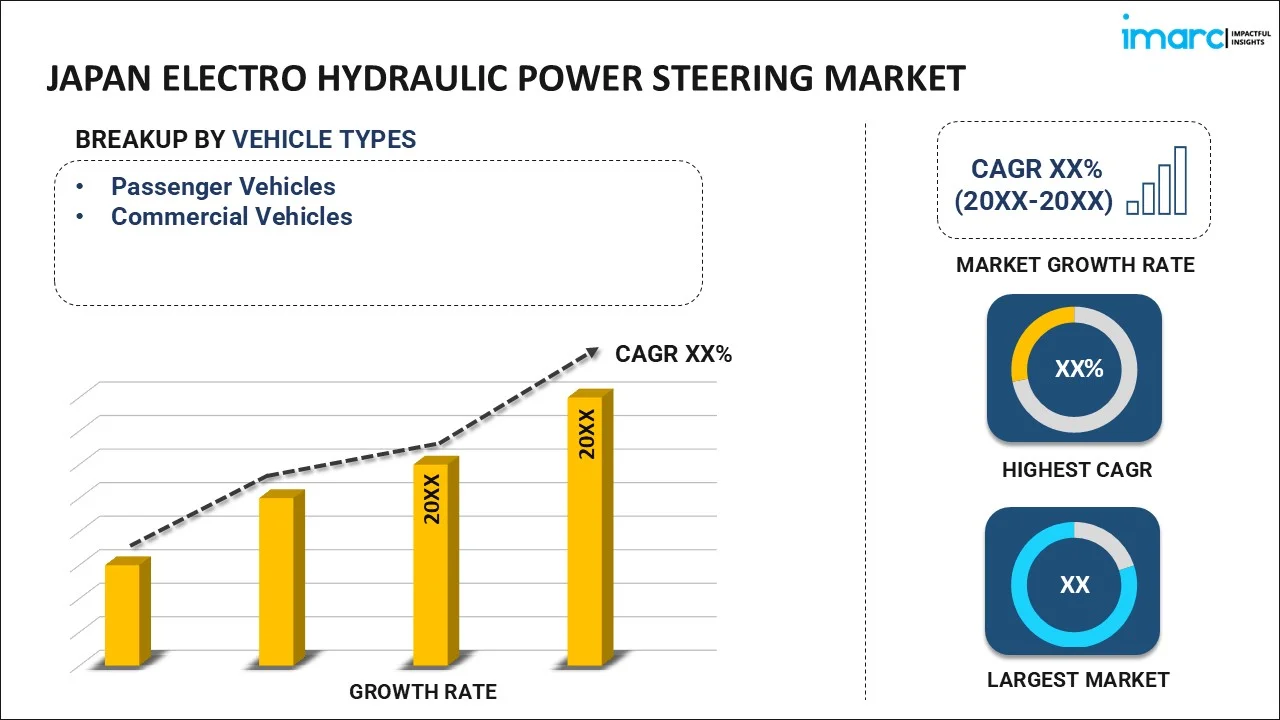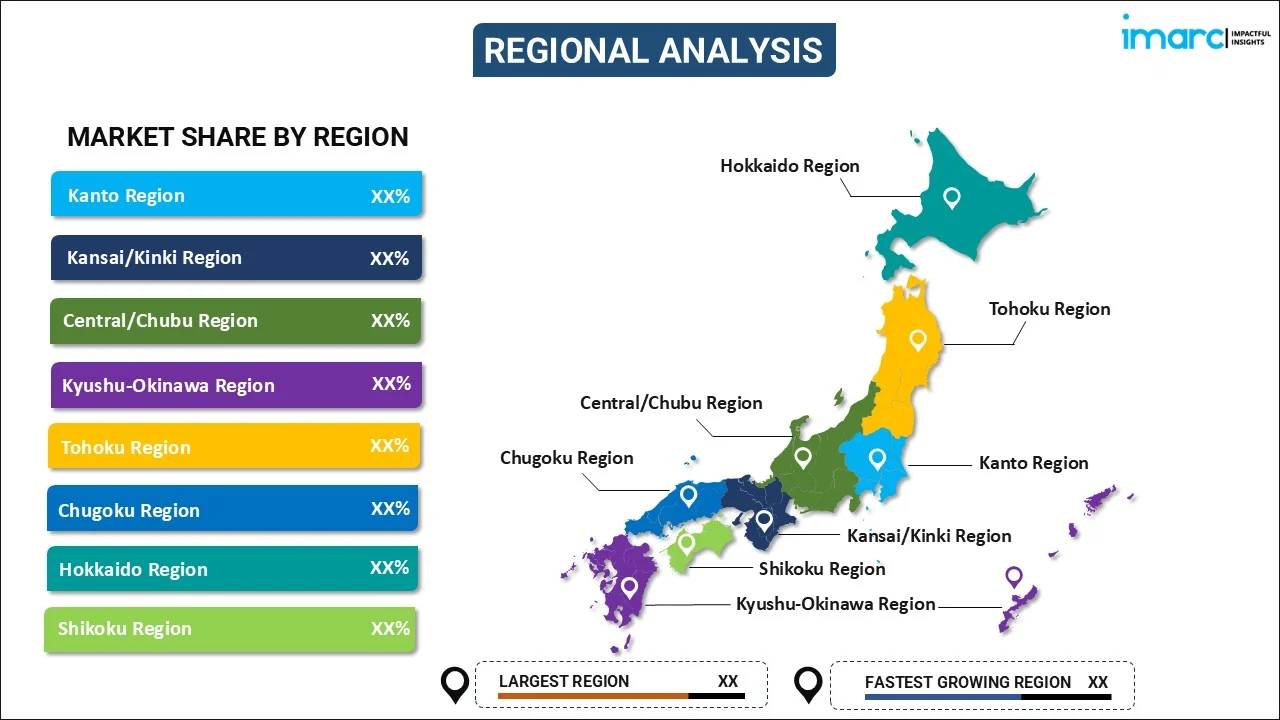
Japan Electro Hydraulic Power Steering Market Size, Share, Trends and Forecast by Vehicle Type, Component Type, and Region, 2025-2033
Japan Electro Hydraulic Power Steering Market Overview:
The Japan electro hydraulic power steering market size reached USD 1,656.70 Million in 2024. Looking forward, IMARC Group expects the market to reach USD 2,669.42 Million by 2033, exhibiting a growth rate (CAGR) of 5.44% during 2025-2033. The Japan electro hydraulic power steering is growing because of the rising preference for autonomous vehicles, which require highly responsive and adaptable steering systems that can handle complex maneuvers, including automatic lane-keeping, obstacle avoidance, and self-parking. Additionally, the rising demand for luxury vehicles is encouraging the adoption of advanced steering technologies that enhance precision, responsiveness, and overall driving comfort.
|
Report Attribute
|
Key Statistics
|
|---|---|
|
Base Year
|
2024
|
|
Forecast Years
|
2025-2033
|
|
Historical Years
|
2019-2024
|
| Market Size in 2024 | USD 1,656.70 Million |
| Market Forecast in 2033 | USD 2,669.42 Million |
| Market Growth Rate 2025-2033 | 5.44% |
Japan Electro Hydraulic Power Steering Market Trends:
Growing Popularity of Autonomous Vehicle Development
The rising interest in self-driving cars among people is a crucial element driving the growth of the electro-hydraulic power steering (EHPS) market. Self-driving technology necessitates extremely responsive and flexible steering mechanisms capable of managing intricate maneuvers, such as automatic lane maintenance, obstacle evasion, and self-parking. EHPS is essential for facilitating these functions by merging the dependability of hydraulic steering with the effectiveness of electric assistance, guaranteeing accurate control and smooth integration with sophisticated driver-assistance systems (ADAS). Car manufacturers are vigorously investing in self-driving technology, incorporating EHPS to improve vehicle stability and flexibility. In 2025, Waymo revealed intentions to start testing self-driving Jaguar I-PACE electric cars in Tokyo. The firm will partner with Japan's biggest taxi company, Nihon Kotsu, and the taxi application 'GO' to adjust to regional driving conditions. Testing will commence in early 2025, concentrating on safety and performance validation within Tokyo’s bustling urban setting, where immediate steering modifications are essential. The increasing focus on autonomous transportation is fueling the adoption of EHPS, since its capability to deliver precise and smooth steering modifications matches the changing needs of next-generation automobiles. As Japanese car manufacturers hasten the creation of semi-autonomous and fully autonomous vehicles, EHPS is evolving into an essential technology, strengthening its influence in the market.
Rising Preference for Luxury and High-Performance Vehicles
The increasing demand for luxury and high-performance cars is leading to the implementation of sophisticated steering technologies that provide greater precision, responsiveness, and overall driving comfort. EHPS systems fulfill these needs by providing a compromise between the robustness of conventional hydraulic steering and the efficiency of electric assist, enabling more flexibility in steering dynamics. Auto manufacturers are adding EHPS to meet user demand for high-end cars that provide better handling and an improved driving experience. EHPS also lowers energy utilization than traditional hydraulic systems, enhancing fuel economy and responding to the industry's drive toward sustainability. The market is also seeing a huge rise in the production of electric vehicles (EVs), where EHPS is picking up pace with its smooth integration into electric drivetrains, ensuring optimal energy usage while exercising control. This trend is especially strong in the luxury EV segment, where luxury models focus on performance and comfort. In 2024, BYD launched the Seal EV in Japan, its priciest model in the market, with rear-wheel and all-wheel drive models offering up to 640 km of range. The launch of premium EVs is indicative of the growing demand for sophisticated steering solutions, making EHPS a central piece in the new automotive environment.
Japan Electro Hydraulic Power Steering Market Segmentation:
IMARC Group provides an analysis of the key trends in each segment of the market, along with forecasts at the region level for 2025-2033. Our report has categorized the market based on vehicle type and component type.
Vehicle Type Insights:

- Passenger Vehicles
- Commercial Vehicles
The report has provided a detailed breakup and analysis of the market based on the vehicle type. This includes passenger vehicles and commercial vehicles.
Component Type Insights:
- Steering Motor
- Sensors
- Others
A detailed breakup and analysis of the market based on the component type have also been provided in the report. This includes steering motor, sensors, and others.
Regional Insights:

- Kanto Region
- Kansai/Kinki Region
- Central/ Chubu Region
- Kyushu-Okinawa Region
- Tohoku Region
- Chugoku Region
- Hokkaido Region
- Shikoku Region
The report has also provided a comprehensive analysis of all the major regional markets, which include Kanto Region, Kansai/Kinki Region, Central/ Chubu Region, Kyushu-Okinawa Region, Tohoku Region, Chugoku Region, Hokkaido Region, and Shikoku Region.
Competitive Landscape:
The market research report has also provided a comprehensive analysis of the competitive landscape. Competitive analysis such as market structure, key player positioning, top winning strategies, competitive dashboard, and company evaluation quadrant has been covered in the report. Also, detailed profiles of all major companies have been provided.
Japan Electro Hydraulic Power Steering Market Report Coverage:
| Report Features | Details |
|---|---|
| Base Year of the Analysis | 2024 |
| Historical Period | 2019-2024 |
| Forecast Period | 2025-2033 |
| Units | Million USD |
| Scope of the Report |
Exploration of Historical Trends and Market Outlook, Industry Catalysts and Challenges, Segment-Wise Historical and Future Market Assessment:
|
| Vehicle Types Covered | Passenger Vehicles, Commercial Vehicles |
| Component Types Covered | Steering Motor, Sensors, Others |
| Regions Covered | Kanto Region, Kansai/Kinki Region, Central/ Chubu Region, Kyushu-Okinawa Region, Tohoku Region, Chugoku Region, Hokkaido Region, Shikoku Region |
| Customization Scope | 10% Free Customization |
| Post-Sale Analyst Support | 10-12 Weeks |
| Delivery Format | PDF and Excel through Email (We can also provide the editable version of the report in PPT/Word format on special request) |
Key Questions Answered in This Report:
- How has the Japan electro hydraulic power steering market performed so far and how will it perform in the coming years?
- What is the breakup of the Japan electro hydraulic power steering market on the basis of vehicle type?
- What is the breakup of the Japan electro hydraulic power steering market on the basis of component type?
- What is the breakup of the Japan electro hydraulic power steering market on the basis of region?
- What are the various stages in the value chain of the Japan electro hydraulic power steering market?
- What are the key driving factors and challenges in the Japan electro hydraulic power steering market?
- What is the structure of the Japan electro hydraulic power steering market and who are the key players?
- What is the degree of competition in the Japan electro hydraulic power steering market?
Key Benefits for Stakeholders:
- IMARC’s industry report offers a comprehensive quantitative analysis of various market segments, historical and current market trends, market forecasts, and dynamics of the Japan electro hydraulic power steering market from 2019-2033.
- The research report provides the latest information on the market drivers, challenges, and opportunities in the Japan electro hydraulic power steering market.
- Porter's five forces analysis assist stakeholders in assessing the impact of new entrants, competitive rivalry, supplier power, buyer power, and the threat of substitution. It helps stakeholders to analyze the level of competition within the Japan electro hydraulic power steering industry and its attractiveness.
- Competitive landscape allows stakeholders to understand their competitive environment and provides an insight into the current positions of key players in the market.
Need more help?
- Speak to our experienced analysts for insights on the current market scenarios.
- Include additional segments and countries to customize the report as per your requirement.
- Gain an unparalleled competitive advantage in your domain by understanding how to utilize the report and positively impacting your operations and revenue.
- For further assistance, please connect with our analysts.
 Inquire Before Buying
Inquire Before Buying
 Speak to an Analyst
Speak to an Analyst
 Request Brochure
Request Brochure
 Request Customization
Request Customization




.webp)




.webp)












